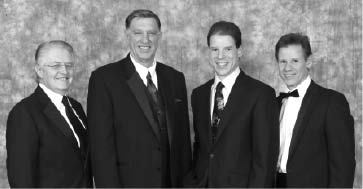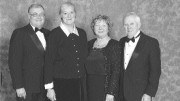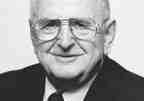The Canadian Mining Hall of Fame, of which The Northern Miner is a sponsor, welcomed five new inductees at its twenty-fourth annual induction dinner in mid-January at the Fairmont Royal York Hotel in Toronto.
Franco-Nevada chairman Pierre Lassonde resumed his master of ceremony role for the eleventh time, before a record crowd of more than 900 that spilled over into a side room.
Robert Hunter (1927-2007) and Robert Dickinson (born 1948), the twin forces behind the successful Hunter Dickinson group of companies, were jointly inducted. Together built a strong team that has raised hundreds of millions of dollars for global exploration and development projects, and played a major role in the development of more than ten major mining projects.
Before presenting the honours, Hunter Dickinson president and CEO Ronald Thiessen painted a portrait of the “two Bobs,” as they became known, as a duo that had complementary talents and personalities.
“Bob H. And Bob D. were as different as can be imagined,” Thiessen said. “One, statesman-like, intuitive, dapper, gregarious and routine. The other, informal, intense and detailed, tactical, a need for occasional solitude, but still a potential for spontaneity. They were very different, but seemed to fit together extremely well.”
The resulting partnership made something that was greater than the sum of its parts, Thiessen continued. “One Bob plus one Bob not only gave you two Bobs, but it gave the Canadian mining industry, our shareholders, and other stakeholders many successful resource developments.”
Both from British Columbia and equally passionate about mining, the two Bobs came from very different backgrounds. Hunter joined the mining industry in the early 1980s, after a successful 20-year career as a life insurance agent. Before teaming up with Dickinson, Hunter was president of Breakwater Resources during the company’s discovery and development of the Cannon gold mine in Washington state. Hunter, who died in 2007, was also one of the first Canadian mining executives to raise money in London and other European financial centres.
Dickinson, meanwhile, discovered his passion for geology and mining early on, as a high school student working for a summer at an exploration camp. Dickinson went on to earn a B.Sc. in geology and an MBA, then worked as an exploration geologist for several majors and juniors, as well as working as a mining analyst, before partnering with Hunter in the mid-1980s.
In his acceptance speech, Dickinson said that when he first met Hunter in 1985, they both knew immediately they would make a good team.
“I was 37 years old and he was 58. We didn’t know each other, but we’d both been asked to run a company together,” Dickinson recalled. “And within ten minutes of meeting each other we said, ‘OK, let’s do it.’ Over the following two years, our first adventure, North American Metals, became a great success, and the rest is history.”
In 1988, Homestake Mining paid $40 million for North American Metals’ interest in the Golden Bear project in B.C. The gold mine began production the next year.
With Hunter’s talents and tenacity as a promoter, making up to a hundred cold calls a day, and Dickinson’s technical expertise, more success followed. Through Continental Gold, the duo advanced the Mount Milligan copper-gold project, in B.C., to feasibility and attracted a $182-million takeover by Placer Dome in 1990. Bringing new partners into the Hunter Dickinson fold, they discovered and developed the Kemess copper-gold mine through El Condor Resources, which was acquired by Royal Oak Mines in 1996.
The Hunter Dickinson Group has provided management, financial and technical services to 17 public companies with more than 40 projects on six continents. Those include: the Pebble deposit in Alaska, which hosts one of the world’s largest copper-gold-molybdenum resources; the Campo Morado zinc mine in Mexico; the Burnstone gold mine in South Africa; and the Hollister gold mine in Nevada.
Part of its success, said Dickinson, has been the group’s ability to attract highly skilled talent that was just as passionate about finding and developing mines as its founders.
“There’s only one thing I love more dearly than the mining industry and the role I play at Hunter Dickinson, and that is my family,” he said, thanking his wife Carmen and two children for their support.
Two of Hunter’s seven children, Scott and David accepted the award on his behalf.
“My father had a tremendous respect for the geologists, engineers, and all the people that worked for them,” said Scott Hunter. “He knew that his success wasn’t possible without the contributions of all of these people.”
Inductee Phillip Hallof (1931-1992) was born in St. Louis, Mo., and earned a bachelor’s degree in geology with a geophysics option from the Massachusetts Institute of Technology in 1952. While a graduate student there, he delved into the then-novel variable frequency induced-polarization (IP) method being developed by Newmont Exploration, and showed that it gave measurable responses over certain known sulphide deposits. This technology was refined and field-tested, resulting in a valuable new tool to identify buried mineral deposits that were not conductive and invisible to conventional electromagnetic (EM) surveys. He created a new mode of displaying multi-spaced IP and resistivity data in the now standard pseudo-section format.
After picking up his PhD from MIT in 1957, Hallof joined McPhar Geophysics in Toronto as chief geophysicist, and became president – and a Canadian citizen – in 1961. He led the company into the forefront of IP science and spearheaded a range of innovations in electrical and EM geophysical techniques.
Following the sale of McPhar Geophysics to CIL in 1975, Hallof founded Phoenix Geophysics, which achieved advances in both Spectral IP Complex Resistivity and Magnetotellurics. Both companies designed, manufactured and marketed geophysical equipment worldwide, and carried out geophysical surveys.
In 1986, Hallof consulted for mining companies and guided the start-up and early growth of Quantec Geoscience.
He was a tireless promoter of advanced geophysics to non-specialists, and a prolific author of technical papers and case studies based on an ever-growing number of exploration successes. In time, IP became a dominant exploration tool worldwide, notably for porphyry copper deposits, sedimentary exhalative massive sulphide deposits and precious metal deposits associated with minor pyrite, and others.
Today, Hallof is recognized as a “father of modern geophysics” for his pioneering and innovative work, and for helping make Canada the “geophysical capital of the world.”
Lois Hallof, Philip’s widow, took to the podium to accept the honour, describing it as “an extremely emotional and proud moment for me and my family.”
“Phil was somewhat of a workaholic but he had a very, very enthusiastic approach and loved to listen to new ideas and was very interested in new technologies,” Lois said. “He was also very interested in students, and wanted to encourage them all the time.”
Inductee John Hansuld (b. 1931) thanked colleagues, friends and family for his many success.
Hansuld has played many roles in his distinguished career in Canada’s mining and minerals sector, from pioneering geochemist to entrepreneur to industry advocate.
As a scientist, he advanced the application of geochemical techniques to mineral exploration and enhanced the profile and prestige of its practitioners. As a corporate leader, he built Amax Exploration Canada into a premier exploration and mine development group later taken public as Canamax Resources. And as an advocate, he helped transform the Prospectors and Developers Association of Canada from a largely Canadian organization to one of global influence.
Hansuld is best remembered by m
any in the junior exploration sector for his leadership in promoting the “flow-through share” tax-incentive program to fund Canadian mineral exploration at a time when many juniors were finding it tough to access traditional capital markets. Flow-through shares became a popular financing option, envied worldwide and used with great success to discover and develop mineral deposits in Canada.
Born and raised in Ontario, Hansuld earned his B.Sc. honours degree in geology at McMaster University in 1954, an M.Sc. degree from the University of British Columbia, and a PhD in geological sciences from McGill University in 1961. Topping it off was a PMD from Harvard Business School in 1968.
Hansuld began at Amax as a geochemist in 1961, moving to Denver a year later as chief geochemist and manager of exploration research. There, he became a pioneer in the application of geochemical techniques to mineral exploration, notably by introducing the concept of Eh-pH phase equilibria diagrams to aid in understanding the relative mobility of common metals in the secondary dispersion media.
He helped organize the first International Geochemical Symposium in Denver, and launch the Association of Exploration Geochemists.
In the late 1970s, Hansuld built Amax Exploration Canada into one of the largest Canadian exploration groups, with 91 projects across the nation. In 1982, he convinced Amax to spin out the Canadian projects into a new company that went on to develop the Bell Creek, Kremzar and Ketza River gold mines. The IPO for Canamax Resources sold out at just under $30 million in the first half of 1983, largely based on flow-through shares. This financing led to the widespread use of the flow-through program, mainly through the formation of limited partnerships, with some $5 billion of flow-through capital raised for Canadian mineral exploration over the next five years. Hansuld was thus dubbed “the father of flow-through” for his role in bringing this innovative financing program to mineral exploration.
As PDAC president from 1993 to 1996, Hansuld helped revitalize the association by adopting a new logo, establishing a strategic plan and expanding the international focus of its annual convention. The PDAC named him Developer of the Year in 1989, in addition to other honours bestowed over the years.
Ned Goodman – a company builder, merchant banker and investment advisor whose career has spanned nearly 50 years – was the fifth and final inductee celebrated during the evening. “Ned needs no introduction to anyone who has ever needed capital for a mineral project, or investment advice, which really covers most of us in this room,” Lassonde said in his opening remarks. “Ned actually hired me in 1980 to work as his understudy and it felt a little bit like, ah, scooping up behind an elephant.”
After studying geology at McGill University (“only to discover that geologists are poor and don’t date much,” Lassonde joked) and a brief stint at Noranda, Goodman went on to complete an MBA from the University of Toronto in 1962 and earn the designation of Chartered Financial Analyst in 1967. He then co-founded with his friend, Seymour Schulich, Beutel, Goodman & Co., which offered pension funds and private client investment advice. “That’s where he put his geological training and business skills together and established the firm as the go-to-destination for mining investment,” Lassonde said. “His creativity knew no bounds. His ability to design complex financial structures became known in the business as the ‘Ned Factor.’ More often than not it left analysts scratching their heads [and] most of the time he was so far ahead of them that they had no clue what he was talking about. But nonetheless he backed unconventional projects that majors had rejected, juniors with new theories and concepts, and early stage projects in foreign lands.”
In the mid-1980s Goodman made the leap into the gold business, becoming the largest shareholder and chairman of International Corona. Over the following years he was involved in the creation of Kinross Gold, Repadre Capital (now Iamgold) and Dundee Precious Metals. He was also an early backer of FNX (later Quadra FNX Mining). Along the way Goodman championed flow-through-shares as a novel way of financing projects and founded the first exploration flow-through partnership, CMP Group, which raised nearly $5 billion in flow-through-shares to help build mining companies. Goodman was also the driving force behind the Dundee Group of Financial Companies, which grew under his leadership from a $600 million base to over a $25 billion mutual fund entity. “Dundee was and still is on every miner’s must-call list, reaffirming what has been said about Ned many times, that he has a gift for working patiently and intelligently with money, making it available to work with and for others, including talented junior companies,” Lassonde said. In addition to being an industry giant known for his entrepreneurial skills and financial genius, Lassonde noted, Goodman has been a prominent philanthropist lending his energy, talent and resources to many worthy causes.
In his speech, Goodman thanked those who wrote letters of recommendation on his behalf, (“they all said nice things, some were even true”) and due to time constraints quoted from only one, written by entrepreneur Robert Friedland (“because I obviously agree with him on this”). “From the early days of my career in the resources industry I quickly came to respect the knowledge and judgment possessed by geologists; the men and women who go out into the cold and the dark to the four corners of the earth and crack open rocks of interest. Geologists are the gatekeeper to the discoveries that quicken the pulses of investors and are the key to the buildings and machinery that shelter and drive our modern lives.”
Goodman thanked the many people who had supported him in his career along the way. “Some say I’ve been lucky and I have, but luck only comes from being associated with the right people. I’ll start tonight especially with my lovely wife Anita, who has put up with me from since I started my career as a geologist, often being away from her and our family.” He thanked his four sons Jonathan, David, Mark and Daniel, his business partners Austin Beutel (“who since 1962 has been my investment advisor; I am a patient value investor taught by him”) and Seymour Schulich (“a friend and partner”). He thanked Bob Buchan and Richard Renaud of CMP Group and “the superb group of people who work with me at Dundee Corporation” and a host of others.
“When you work with people like this you don’t need luck you only need a culture that operates as a family,” Goodman says. “I’m a big believer in the family culture . . . [and] the culture that built my career, a culture of passion, integrity, character, and my word being my bond. Over my career I’ve probably done billions of dollars of deals on a handshake or telephone call.”
In closing, Goodman described himself as “a constant optimist” (“Seymour once told me he never met a rich pessimist and I believed him and I still do.”) and mentioned Dundee is buying a cattle ranch in BC. In his reading about ranching and cowboys, Goodman came across James P. Owen’s “Cowboy Ethics: What Wall Street Can Learn From The Code of the West” and took it to heart: “Living by the code of cowboy ethics is very simple and it is taken from the simple principle that endures in most of all religions,” Goodman said. “Treat thy neighbour as thyself, the golden rule, and knowing right from wrong.”
– For more information, visit the Canadian Mining Hall of Fame at its permanent home in the Royal Ontario Museum, a satellite installation at the Britannia Mine Museum in B.C. or at mininghalloffame.ca.






Be the first to comment on "Canadian Mining Hall of Fame welcomes five inductees"